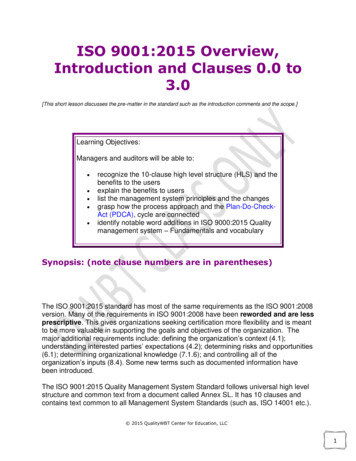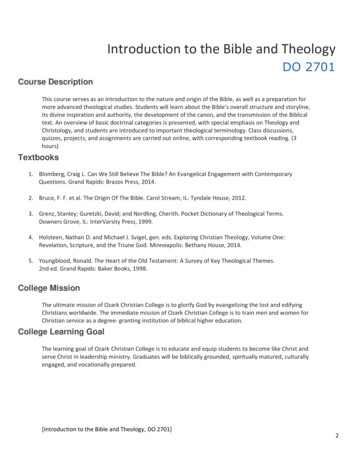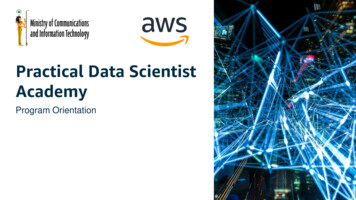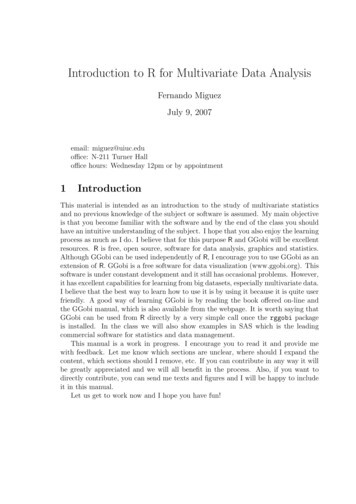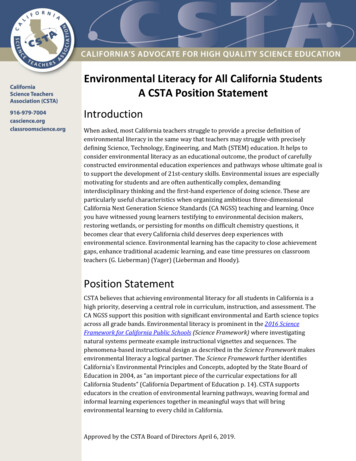
Transcription
Environmental Literacy for All California StudentsA CSTA Position StatementIntroductionWhen asked, most California teachers struggle to provide a precise definition ofenvironmental literacy in the same way that teachers may struggle with preciselydefining Science, Technology, Engineering, and Math (STEM) education. It helps toconsider environmental literacy as an educational outcome, the product of carefullyconstructed environmental education experiences and pathways whose ultimate goal isto support the development of 21st-century skills. Environmental issues are especiallymotivating for students and are often authentically complex, demandinginterdisciplinary thinking and the first-hand experience of doing science. These areparticularly useful characteristics when organizing ambitious three-dimensionalCalifornia Next Generation Science Standards (CA NGSS) teaching and learning. Onceyou have witnessed young learners testifying to environmental decision makers,restoring wetlands, or persisting for months on difficult chemistry questions, itbecomes clear that every California child deserves deep experiences withenvironmental science. Environmental learning has the capacity to close achievementgaps, enhance traditional academic learning, and ease time pressures on classroomteachers (G. Lieberman) (Yager) (Lieberman and Hoody).Position StatementCSTA believes that achieving environmental literacy for all students in California is ahigh priority, deserving a central role in curriculum, instruction, and assessment. TheCA NGSS support this position with significant environmental and Earth science topicsacross all grade bands. Environmental literacy is prominent in the 2016 ScienceFramework for California Public Schools (Science Framework) where investigatingnatural systems permeate example instructional vignettes and sequences. Thephenomena-based instructional design as described in the Science Framework makesenvironmental literacy a logical partner. The Science Framework further identifiesCalifornia’s Environmental Principles and Concepts, adopted by the State Board ofEducation in 2004, as “an important piece of the curricular expectations for allCalifornia Students” (California Department of Education p. 14). CSTA supportseducators in the creation of environmental learning pathways, weaving formal andinformal learning experiences together in meaningful ways that will bringenvironmental learning to every child in California.Approved by the CSTA Board of Directors April 6, 2019.
A Succinct Definition of Environmental LiteracyEnvironmental literacy is an understanding of how natural environments influenceindividual organisms, including humans, and how organisms, especially humans, inturn, influence the planet’s natural systems.BackgroundBeing literate, in the broadest sense, means to have knowledge or competence to act inthe targeted field, whether writing, quantifying, or investigating 21st-centuryenvironmental issues (Roadmap). CSTA believes that environmental literacy is theoutcome of an intentional learning program coupled with the direct experience ofmaking sense of environmental issues. Students are able to explore and gain anunderstanding of the Earth and Human Activity Disciplinary Core Ideas (CaliforniaDepartment of Education p. 49) within the CA NGSS by using the Science andEngineering Practices and refining thinking with the Crosscutting Concepts. Other vitalperspectives on environmental literacy have been offered by the North AmericanAssociation of Environmental Education and the California Environmental LiteracyInitiative (CAELI). CSTA shares with these organizations a goal of ensuring that everychild gains access to high-quality environmental learning pathways.CSTA believes teaching with an emphasis on local environmental issues enablesstudents and their communities to be “sustainable,” providing students the necessarytools to be conscious consumers, informed members of society, and knowledgeableadvocates for natural resources and systems. This learning can be empowering andparticularly relevant to students personally experiencing the environmental injustice ofair, water, and soil pollution.CSTA believes that an environmentally literate person: Habitually recognizes and acts on the knowledge of how natural and humansystems are woven together to produce ecosystem services upon whichhumans and the natural environment are both dependent.Makes decisions informed by environmental science (including traditionalecological knowledge from diverse cultures) and habitually acts to sustain thenatural environment for future generations.Recognizes that access to high-quality, culturally relevant environmentallearning opportunities for every student is a social justice issue and thatbarriers to environmental learning must be removed via thoughtful collectiveaction and integration into the TK-16 educational system.Approved by the CSTA Board of Directors April 6, 2019.
Understands and is motivated to act using the ideals, principles, and practicesof civic engagement to participate in resolving issues.Understands that what people do as individuals and groups can make adifference.Implications for Classroom InstructionTeachers are frequently asked to shoulder another task, burden, or program, often withdistracting consequences for their ability to provide high-quality learning experiences.The truth is that environmental learning is not just one more thing; it is a pathway toproviding integrative three-dimensional learning that will when done thoughtfully,have the potential to actually ease time demands on teachers. The 2016 CaliforniaScience Framework describes three essential elements of CA NGSS instruction,including that instruction should be: “relevant to local communities and studentinterests. Content and practices build on students’ existing experience to learn about andsolve real-world societal and environmental problems” (p.8).Transitioning to the use of environmental issues as a context for learning increasesinterest in STEM by traditionally underrepresented students, supporting the idea thatenvironmental learning is an equity strategy.Strong support for using the environment as a context for learning may be seen in thethree instructional strategies endorsed by Chapter 11 of the 2016 California ScienceFramework. Each strategy is linked to environmental issues explicitly by the authors ofthe framework, reflecting their intention to ensure that every child has access toenvironmental learning: Problem Based Learning: The example utilizes a critical environmental issue asan anchor phenomenon. “In PBL, the problem is introduced at the beginning asthe motivation for an entire unit. For example, a high school unit might begin byintroducing the problems caused by climate change. During the unit, studentswill develop solutions that minimize the release of carbon dioxide into theatmosphere from burning fossil fuel. Along the way, they will develop scientificconcepts of energy (physics), natural resources (Earth and space science), andfuel (chemistry) to support their development of engineering solutions (whichmight include energy conservation techniques and alternative energy sources)”(p. 1454).The BSCS 5E Instructional Model: Environmental issues permeate theframework as may be seen in the vignettes, especially with respect to thephenomena used to launch the 5E instructional sequences. From theframework: “Many of the phenomena selected illustrate California’sApproved by the CSTA Board of Directors April 6, 2019.
Environmental Principles and Concepts (EP&Cs), which are an essential part ofthe CA NGSS” (p.777).Outdoor Learning: “Outdoor and environmental learning experiences arepowerful tools for implementing key instructional shifts required by the CANGSS. . There is wide-ranging evidence to support the value of using naturalenvironments, local communities, and other outdoor settings as a real-worldcontext for science learning that engages student interest as they investigateplaces around them (Lieberman and Hoody 1998; Lieberman 2013; AmericanInstitutes for Research 2005; Lozar 2000). Students should have richopportunities to observe and investigate the multitude of natural and humansocial systems found throughout California” (p.1455).Environmental issues lend themselves to cross-disciplinary integrative learning andscience teachers are central to the effort to bring environmental literacy to everyCalifornia child. California’s Department of Education (CDE) considers environmentalliteracy the “bridge across subject areas” that will allow the “pedagogical convergence”of Mathematics, English Language Arts, Next Generation Science Standards, HistorySocial Science, Health and Career Technical Education to produce the 21st-centuryskills so sought after by employers (Glen Price Group).At the heart of this broader integrative effort is three-dimensional science learning(NGSS) that emerges from the facilitation of rich environmental learning experiences.These are not two distinct efforts; instead, CSTA joins the Association for Supervisionand Curriculum Development (ASCD) in believing that K-12 “schools should provideenvironmental education.” Such rich learning opportunities empower students toinvestigate and explain phenomena in their world, strengthening both environmentaland scientific literacy of these youth who are the parents, community members, andleaders of tomorrow.ReferencesCalifornia Department of Education. "2016 Science Framework." Vers. Final PublishedVersion. 3 November 2016. California Department of Education. PDF. 23 May2019. 2016.asp .Glen Price Group. "A Blueprint for Environmental Literacy." 2015. CaliforniaDepartment of Education. California State Superintendent of Public InstructionTom Torlakson’s statewide Environmental Literacy Task Force (ELTF). PDF. 23May 2019. iteracyblueprint.pdf .Lieberman, Gerald A and Linda L Hoody. Closing the Achievement Gap: Using theEnvironment as an Integrating Context for Learning. Results of a NationwideApproved by the CSTA Board of Directors April 6, 2019.
Study. San Diego: State Education and Environment Roundtable, 1998. 23 May2019. https://eric.ed.gov/?id ED428943 .Lieberman, Gerald. Education and the Envirnoment: Creating Standards-Based Programsin Schools and Districts. Cambridge: Harvard Education Press, 2013."Roadmap." 2011. Environmental Literacy Vermont. PDF. 23 05 2019. ploads/2016/02/Roadmap printable.pdf .Yager, Robert. Exemplary Science in Informal Education Settings. Ed. John Falk.Arlington: National Science Teachers Association, 2007.Approved by the CSTA Board of Directors April 6, 2019.
Introduction When asked, most California teachers struggle to provide a precise definition of environmental literacy in the same way that teachers may struggle with precisely defining Science, Technology, Engineering, and Math (STEM) education. It helps to consider environmental literacy as an educational outcome, the product of carefully

